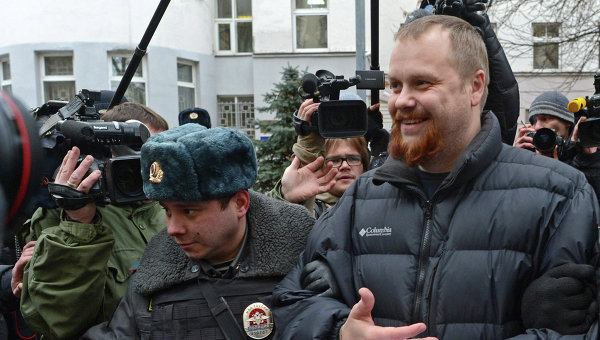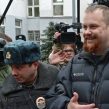
Russian Neo-Nazis Organize Rally in Moscow
Publication: Eurasia Daily Monitor Volume: 10 Issue: 167
By:

The “Russkie” organization, which emerged out of the 2011–2012 protest movement against the ruling United Russia party and now-President Vladimir Putin, organized a rally on September 14 to protest the “distribution of Russian citizenship,” a legislative act that received its first reading in the State Duma on Friday. The law, “about the rights of foreign citizens in the Russian Federation,” would ease Russian language requirements for citizens of the Former Soviet Union (FSU) and make naturalization easier. According to Russia’s Ministry of Foreign Affairs, 100,921 people from outside the Russian Federation applied for citizenship between 2010 and 2012 (https://www.regnum.ru/news/1707456.html), but presumably, with the aid of this new law, this number would increase. The law fulfills a request Putin made to the Duma to draft such a bill on April 30, 2013 (https://www.regnum.ru/news/1654934.html). Russia is in need of more people in the labor market to sustain economic development—an especially severe problem given that between 1989 and 2012, Russia’s population shrank by nearly 9 million people, which has represented the largest decline in a country outside of wartime. Today, many of the workers on Russian building sites and in Russian markets come from neighboring countries in the post-Soviet space, including Central Asia and the South Caucasus. Yet despite the economic imperatives driving the law, it is controversial because many ethnic Russians see people from the FSU—and even internal migrants from the North Caucasus—as threatening to a relatively homogenous Russian culture (see EDM, October, 27, 2011; November 26, 2012; September 6, 9; 2013).
Last week’s Moscow protests were organized by the Russkie movement, of which the two main affiliates are the Movement Against Illegal Immigration (known by its Russian acronym “DPNI” and led by Alexander Belov—real name Potkin: “Belov” is derived from the Russian word for “white”) and the Slavic Union (the most widespread—now banned—skinhead gang in Russia, known by its provocative Russian acronym that references the Nazi SS). According to the website of the DPNI, the protests seemed to be national in scope, with rallies planned in Moscow, Astrakhan, Krasnoyarsk, Nizhny Novgorod, Novosibersk, Penza, Syktyvkar, St. Petersburg and Khabarovsk. Smaller protests had been agreed in “Chelyabinsk and Volgograd and other cities” (https://www.dpni.org/articles/vazhnoe/37257/). The Moscow rally was held on Pushkin square and attracted around 200 people (https://www.gazeta.ru/social/news/2013/09/14/n_3183197.shtml). The target of the Moscow protest was “the distribution of Russian citizenship to Central Asians and Caucasians” and also drew one unnamed member of the Duma (https://www.dpni.org/articles/novostnaya/37276/). The “unsanctioned protest” resulted in the arrest of 25 people (https://www.mk.ru/moscow/news/2013/09/14/915443-na-nesanktsionirovannoy-aktsii-v-moskve-zaderzhanyi-25-chelovek.html). Apparently the authorities were well-prepared for the protest and had two police vehicles and many officers present. The DPNI’s own members described “OMON [Russian riot police] on every corner” (https://www.dpni.org/articles/novostnaya/37276/), a claim that implies the Russian authorities are well aware of and concerned about the dangers implied by the promotion of ethnic nationalism in a multi-ethnic country.
While it is unclear whether the rallies in other Russian cities were also unsanctioned, they apparently were not as well-attended as the one in Moscow. Photographs of the rally in Astrakhan, for example, show possibly 30 activists with the Imperial black-gold-white striped Russian flag—a symbol popularly adopted by Russia’s far-right nationalists (https://www.dpni.org/articles/novostnaya/37291/). The Penza rally had less than 20 protestors (https://www.dpni.org/articles/novostnaya/37290/), the Krasnoyarsk rally possibly 30 protestors (https://www.dpni.org/articles/novostnaya/37289/), and the rally in the ethnic republic of Komi had fewer than two dozen participants (https://www.dpni.org/articles/novostnaya/37289/). The rally in St. Petersburg attracted two dozen picketers and was held along Nevsky Prospect (https://www.dpni.org/articles/novostnaya/37280/). Although attendance at the rallies may not have been sizeable, the ability of the DPNI to marshal a cross-country response to the law is nevertheless impressive and suggests the sense of threat felt by ethnic Russian nationalists.
The DPNI had certainly prepared a great deal of material for the protest. The organization provided protest materials and links to informational resources, including posters featuring Central Asian and Caucasian faces that proclaimed: “Yesterday they came into our country in order to live. Now they dictate our rights. Tomorrow they may become citizens. They will elect their own President, their own government to make new laws.” Other slogans were more direct, instructing people to “Stop the Occupation!” or simply “Protest!” (https://www.dpni.org/articles/vazhnoe/37211/). Other “agitation materials” included pictures of Russian girls in kitsch dress with the slogan “Russia is Russian land,” as well as a sign bearing the words, “We do not need a Russia without [ethnic] Russians,” and, “Putin is the President of Tajikistan”—apparently drawing attention to the growing number of Tajik migrants to Russia (https://www.dpni.org/articles/vazhnoe/37252/). The group also compiled a specific list of slogans approved for the protest that included all of those listed above as well as the command: “Putin, stop bringing migrants!” The protest materials reinforce the sense that the rally was as much about the ethnic status of Russians in the Russian Federation as it was about the naturalization of foreigners.
The drafting of the naturalization law demonstrates the polarization of and contradictions inherent in Russian society two decades after the fall of Communism. Recent polls show that Russians retain an ethnic definition of nationality, with 44 percent saying that Ukrainians may become Russian after living there a few years, versus just 7 percent who say the same about Chechen or Dagestani people—even though the latter are already legally citizens of the Russian Federation (https://www.themoscowtimes.com/news/article/most-russians-dont-want-gays-as-neighbors-poll-finds/485903.html). Such sentiments blatantly contradict the official conception of the Russian nation as a civic community that transcends ethnicity. Moreover, many Russians associate those belonging to other ethnic groups with criminal activity, a view affirmed by Putin in December 2010 when he declared the need to clamp down on ethnic crime (https://www.vz.ru/news/2010/12/27/457978.html). Some Russians view Neo-Nazi skinheads as protectors of their communities from this criminal threat, as was illustrated by a Russian nationalist attack on foreign merchants in St. Petersburg on July 31 (see EDM, August 5).
The rallies are also evidence of the enduring power of ethnic nationalism to bring Russians out onto the street and even risk arrest. While the rallies were small, the number of people in attendance looks larger when one considers that there has been little overall public attention paid to this law and that many members of the Russian opposition are exhausted after two years of protesting amidst government crackdowns (see EDM, September 9). Nationality, it seems, is an issue that will not go away.




